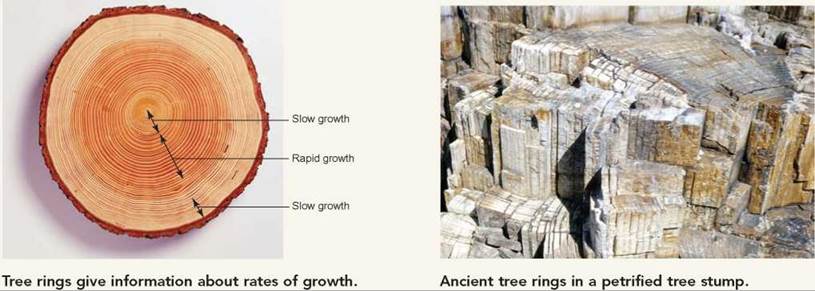CONCEPTS IN BIOLOGY
PART V. THE ORIGIN AND CLASSIFICATION OF LIFE
22. The Plants Kingdom
22.9. The Growth of Woody Plants
All gymnosperms and a large proportion of the dicots are woody plants. Although these two groups of plants have different evolutionary histories, they share the ability to grow continuously for many years. The trees get taller and larger in diameter each year. Both the stems and the roots grow from their tips and add to their length. In addition, they increase in diameter by adding new xylem and phloem to the outside of the stem.
As a tree becomes larger, the strengthening tissue in the stem becomes more and more important. A layer of cells in the stem, called the vascular cambium, is responsible for this increase in diameter. The vascular cambium is between the xylem and the phloem. Xylem tissue is the innermost part of the tree trunk or limb, and phloem is outside. The bark of the tree, containing the phloem, is important in protecting the underlying tissues. Cambium cells go through a mitotic cell division, and two cells form. One cell remains cambium tissue, and the other specializes to form vascular tissue. If the cell is on the inside of the cambium ring, it becomes xylem; if it is on the outside of the cambium ring, it becomes phloem. As cambium cells divide again and again, one cell always remains cambium, and the other becomes vascular tissue. Thus, the tree constantly increases in diameter (figure 22.25) (How Science Works 22.1).

FIGURE 22.25. A Cross Section of Woody Stem
Woody stems are composed of xylem in the middle and a covering of bark on the outside. The phloem is located in the bark. Between the xylem and phloem is the vascular cambium. The cells of the vascular cambium divide and add to the diameter of the stem by adding xylem and phloem.
The accumulation of the xylem in the trunk of gymnosperms and woody angiosperms is called wood. Wood is one of the most valuable biological resources of the world. We get lumber, paper products, turpentine, and many other valuable materials from the wood of gymnosperms and angiosperms. In many areas of the world, firewood is the primary fuel for cooking and heating homes.
As you can see from this discussion, both angiosperms and gymnosperms have members that are woody. Therefore the term woody cuts across taxonomic lines.
HOW SCIENCE WORKS 22.1
Using Information from Tree Rings
Trees that live in seasonal climates produce a ring of new growth each year. These annual rings are visible in the cut stem because in the spring, when trees start to produce new growth, the xylem cells produced are large. The cells produced later in the year are smaller. The abrupt change between the small cells produced in the fall and the large cells produced the following spring is easy to see.
In the accompanying photograph of a cross section of a Douglas fir tree, we can gather several bits of information:
1. We can count the rings and determine that the tree was about 50 years old when it was harvested.
2. By noticing how close together the annual rings are in the center of the stem, we can see that in the early years of its life, it grew relatively slowly.
3. By examining the width of the annual rings in the darker brown area and counting the rings, we can determine that the tree grew rapidly for about 20 years in the middle of its life.
4. Growth then slowed considerably in the later part of the tree's life as evidenced by the narrow annual rings in the outer portion of the stem.
Scientists can use this information for a variety of purposes. Foresters can bore into a tree and obtain a sample of the tree rings to assess how well the tree is growing. Healthy, rapidly growing trees will show wide annual rings, while poorly growing trees will show narrow annual rings. Based on this information they can make decisions about when to harvest trees to get the greatest production from a forest.
Scientists interested in how climate may have changed in the past can look at tree rings and determine if there were periods of drought or other factors that may have altered a tree's growth pattern. Since some trees live for thousands of years, it is possible to use tree rings to get an idea of climate alterations that occurred before recorded history.
Because the trees used in wooden structures were killed when they were harvested, archaeologists can use tree rings to determine the age of artifacts and ancient structures. The tree ring patterns in wooden structures and implements can be examined for patterns of growth that can be correlated with known events. Thus, it is possible to place precise dates on certain archaeological structures. It is even possible of examine growth patterns in petrified wood (see photo).

22.9. CONCEPT REVIEW
21. What is the significance of the vascular cambium tissue in woody perennials?
22. Wood is composed of what kind of cell?